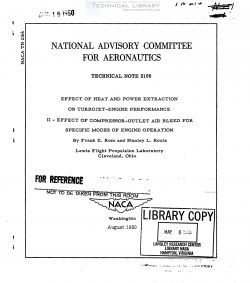naca-tn-2166
- Version
- 131 Downloads
- 750.42 KB File Size
- 1 File Count
- December 14, 2016 Create Date
- December 14, 2016 Last Updated
National Advisory Committee for Aeronautics, Technical Notes - Effect of Heat and Power Extraction on Turbojet Engine Performance - II - Effect of Compressor Outlet Air Bleed for Specific Modes of Engine Operation

The effect of air bleed from the compressor outlet on the per-
formance of turboJet engines with variable-area and rated-area tail-
pipe nozzles was calculated by the use of generalized performance
charts. The modes investigated were constant turbine-inlet tem-
perature and constant thrust operation with fixed and variable tail—
pipe-nozzle areas. The effect of altitude, compressor-inlet tem-
perature, and flight Mach number on engine performance with air bleed
is shown. The maximum amount of air that can be bled from the com-
pressor outlet of a turboJet engine equipped with a variable-area or
rated-area tail-pipe nozzle is also given for various values of alti-
tude and thrust.
For constant turbine-inlet temperature operation, the effect
of air bleed was, in general, to decrease the thrust slightly more
than double and to increase the specific fuel consumption slightly
less than double the percentage of air bled from the compressor
outlet. No significant difference between operation with the
variable-area and rated-area tail-pipe nozzles was noted for the
range of air bleeds investigated.
Considerable quantities of compressed air may be required in
the operation. of current and future aircraft for such uses as
cabin pressurization and conditioning, protection against ice for-
mation, and boundary-layer control. The compressed air can be
obtained from the compressor outlets of turbine-powered airplanes
at the expense of engine performance. An analytical method of
determining the effect of air bleed on turbojet engines is presented
in reference 1, together with a set of generalized performance
charts. The effect of air bleed on engine performance for sev-
eral specific modes of operation we determined at the N'AGA Iewis
laboratory by use of these charts and is presented herein.
The modes of engine operation considered are constant turbine-
inlet temperature and constant thrust operation with both variable
and sea-level rated tail-pipe-nozzle areas. The effects of
compressor-inlet temperature, altitude, and Mach number on engine
performance with air bleed are discussed. In addition, the maxi-
mum amount of air that can be bled from the compressor outlet of
a turboJet engine is presented as a function of altitude and thrust.
| File | Action |
|---|---|
| naca-tn-2166 Effect of Heat and Power Extraction on Turbojet Engine Performance - II - Effect of Compressor Outlet Air Bleed for.pdf | Download |

Comment On This Post